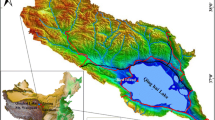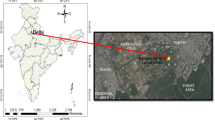A critical analysis made on the long-term monthly, seasonal, yearly variation and annual cycle of total column ozone (TCO) concentration at New Delhi (29°N, 77°E), India and Halley Bay (76°S, 27°W), a British Antarctic Service Station reveals more decline in yearly mean ozone concentration at Halley Bay than at New Delhi from 1979 to 2005. The nature of variations of monthly mean TCO during the months of August and September was the most identical with that of yearly mean ozone values at New Delhi and Halley Bay, respectively, for the same period. Annual cycles of TCO over these stations are completely different for the above period. The effect of O3 depletion on night airglow emission of OH(8, 3) line at New Delhi and Halley Bay has been studied. Calculations based on chemical kinetics show that the airglow intensity of OH(8, 3) has also been affected due to the depletion of O3 concentration. The yearly variations and annual cycle of intensities of OH(8, 3) line for the above two stations are depicted and compared. It has been shown that the rate of decrease of intensity of OH(8, 3) line was comparatively more at Halley Bay due to dramatic decrease of Antarctic O3 concentration.









Similar content being viewed by others
References
Abreu V J and Yee J H 1989 Diurnal and seasonal variation of the nighttime OH(8, 3) emission at low latitudes; J. Geophys. Res. 94(A9) 11,949–11,957.
Bates D R and Nicolet M 1950 The photochemistry of atmospheric water vapour; J. Geophys. Res. 55(3) 301–327.
Batista P P, Takahashi H and Clemesha B R 1994 Solar cycle and the QBO effect on the mesospheric temperature and night glow emissions at a low latitude station; Adv. Space Res. 14(9) 221–224.
Bittner M, Offermann D and Graef H 2000 Mesopause temperature variability above a midlatitude station in Europe; J. Geophys. Res. 105(D2) 2045–2058.
Bodeker G E, Struthers H and Connor B G 2002 Dynamical containment of Antarctic ozone depletion; Geophys. Res. Lett. 29 14,206.
Bojkov R D 1992 Scientific assessment of ozone depletion; WMO Bulletin 41 171.
Breig E L 1970 Secondary production process for the hydroxyl atmospheric airglow; Planet. Space Sci. 18 1271.
Cordero E C and Nathan T R 2002 An examination of anomalously low column ozone in southern hemisphere mid-latitude during 1997; Geophys. Res. Lett. 29 1123, doi: 10.1029/2001GL013948.
De Mesnes F C, Shiguemori E H, Muralikrishna P and Clemesha B R 2011 A representative airglow volume emission profile from rocket-borne photometer data by an artificial neural network technique; J. Comput. Interdisciplinary Sci. 2(2) 99–109.
Dyrland M E, Mulligan F J, Hall C M, Sigernes F, Tsutsumi M and Deehr C S 2010 Response of OH airglow temperatures to neutral air dynamics at 78°N, 16°E during the anomalous 2003–2004 winter; J. Geophys. Res. 115 D07103, doi: 10.1029/2009JD012726.
Farman J C, Gardiner B G and Shanklin J D 1985 Large losses of total ozone in Antarctica reveal seasonal ClOx/NOx interaction; Nature 315 207–210.
Funke B, Lopez-Puertas M, Bermejo-Pantaleon D, Garcia-Comas M, Stiller G P, von Clarmann T, Kiefer M and Linden A 2010 Evidence for dynamical coupling from the lower atmosphere to the thermosphere during a major stratospheric warming; Geophys. Res. Lett. 37 L13803, doi: 10.1029/2010GL043619.
Gao H, Xu J and Wu Q 2010 Seasonal and QBO variations in the OH nightglow emission observed by TIMED/SABER; J. Geophys. Res. 115 A06313, doi: 10.1029/2009JA014641.
Gao H, Xu J, Ward W and Smith A K 2011 Temporal evolution of nightglow emission responses to SSW events observed by TIMED/SABER; J. Geophys. Res. 116 D19110, doi: 10.1029/2011JD015936.
Gattinger R L 1971 The Radiation Atmosphere (ed.) McCormac B M (Dordrecht: D. Reidel), 51p.
Gombosi T I 2004 Physics of the Space Environment; Cambridge University Press.
Greet P A, French W J R, Burns G B, Williams P F B, Lowe R P and Finlayson K 1998 OH(6-2) spectra and rotational temperature measurements at Davis, Antarctica; Ann. Geophys. 16(1) 77–89.
Haider S A, Kim J, Nagy A F, Kellere N, Verigin M I, Gringauz K I, Shutte N M, Szego K and Kiraly P 1992 Calculated ionization rates, ion densities and airglow emission rates due to precipitating electrons in the night side ionosphere of Mars; J. Geophys. Res. 97 10,637–10,641.
Hargreaves J K 1992 The Solar-Terrestrial Environment; Cambridge University Press.
Jacchia L G 1977 SAO Special Report No. 375, Smithsonian Institution Astrophysical Observatory, Cambridge, Massachusetts.
Jana P K and Nandi S C 2005 Effect of solar parameters on Antarctic, artic and tropical ozone during the last solar cycle; Indian J. Radio Space Phys. 34 114–118.
Jana P K and Nandi S C 2006 Ozone decline and its effect on night airglow intensity of Na 5893 Å at Dumdum (22.5°N, 88.5°E) and Halley Bay (76°S, 27° W); J. Earth Syst. Sci. 115 607–613.
Jana P K, Saha I, Das P, Sarkar D and Midya S K 2010a Long-term ozone trend and its effect on night airglow intensity of Li 6708 Å at Ahmedabad (23°N, 72.5°E) and Halley Bay (76°S, 27°W); Indian J. Phys. 84(1) 41–53.
Jana P K, Saha D K and Midya S K 2010b Effect of cloud on atmospheric ozone formation over Kolkata; Indian J. Phys. 84(4) 367–375.
Jana P K, Saha I and Mukhopadhyay S 2011 Long-term ozone decline and its effect on night airglow intensity of Li 6708 at Varanasi (25°N, 83°E) and Halley Bay (76°S, 27°W); J. Earth Syst. Sci. 120(2) 291–300.
Jana P K, Sarkar D, Saha D K and Midya S K 2012 Effect of cloud occurrences on tropospheric ozone over Alipore (22.52°N, 88.33°E); J. Earth Syst. Sci. 121(3) 711–722.
Kerr A 1998 Deep chill triggers record ozone hole; Science 282 391.
Krasnopolsky V A 1986 Oxygen emissions in the night airglow of the earth, Venus and Mars; Planet. Space Sci. 34(6) 511–518.
Krassovsky V J 1956 On the Detection of the Infra-red Night Airglow and Aurrora (eds) Armstrong S B and Dalgarno A (New York, USA: Pargamon Press), 193p.
Krassovsky V I and Shagaev M V 1974 Inhomogeneties and wavelike variations of the rotational temperature of atmospheric hydroxyl; Planet. Space Sci. 22 1334–1337.
Llewellyn E J, Long B H and Solheim B H 1978 The quenching of OH* in the atmosphere; Planet. Space Sci. 26 525–531.
Lowe R P and Turnbull O N 1995 Comparison of ALOHA-93, ANLC-03 and ALOHA-90 observations of the hydroxyl rotational temperature and gravity wave activity; Geophys. Res. Lett. 22 2813–2816.
Madrigal M A and Peraza J P 2005 Analysis of the evolution of the Antarctic ozone hole size; J. Geophys. Res. 110 D02107, doi: 10.1029/2004JD004944.
Meinel A B 1950a Hydride emission bands in the spectrum of the night sky; J. Astrophys. 111 207.
Meinel A B 1950b OH emission bands in the spectrum of the night sky, I; J. Astrophys. 111 555–564.
Meinel A B 1950c OH emission bands in the spectrum of the night sky, II; J. Astrophys. 112 120–130.
Marcos F A 1987 Proceedings of workshop held at AFGC on atmospheric density and aerodynamics drag models for air force operations.
Marsh D R, Smith A K, Mlynczak M G and Russell III J M 2006 SABER observations of the OH Meinel airglow variability near the mesopause; J. Geophys. Res. 111 A10S05, doi: 10.1029/2005JA011451.
Midya S K and Jana P K 2002 Atmospheric ozone depletion and its effect on environment; Indian J. Phys. 76B 107–138.
Midya S K, Jana P K and Mondal S K 1998 OH(8, 3) band emission from different excitation mechanisms; Indian J. Phys. 72B(5) 547–553.
Midya S K and Midya D 1993 The effect of Antarctic O3 decline on night airglow intensity of Na 5893 Å , O5577 Å, OH emissions and its correlation with solar flare numbers; Earth, Moon & Planets 61 175–182.
Mlynczak M G, Zhou D K and Alder-Golden S M 1998 Kinetic and spectroscopic requirements for the inference of chemical heating rates and atomic hydrogen densities from OH Meinel band measurements; Geophys. Res. Lett. 25 647–650.
Nelson D D, Schiffman Jr. A, Nesbitt D J, Orland J J and Burkholder J B 1990 H + O3 → Fourier transform infrared emission and laser absorption studies of OH(X2 π) radical: An experimental dipole moment function and state-to-state, Einstein A coefficients; J. Chem. Phys. 93 7003–7019.
Nicolet M 1970 Ozone and hydrogen reactions; Ann. Geophys. 26 531–546.
Salby M, Callaghan P, Keckhut P, Godin S and Guirlet M 2002 International changes of temperature and ozone, relationship between the lower and upper stratosphere; J. Geophys. Res. 107(D18), doi: 10.1029/2001JD000421.
Sathiskumar S and Sridharan S 2009 Planetary and gravity waves in the mesosphere and lower thermosphere region over Tirunalveli (8.7°N, 77.8°E) during stratospheric warming events; Geophys. Res. Lett. 36 L07806, doi: 10.1029/2008GL037081.
Shephered M G, Liu G and Shephered G G 2006 Mesospheric semiannual oscillation in temperature and nightglow emission; J. Atmos. Sol. Terr. Phys. 68(3–5) 379–389.
Slanger T G, Cosby P C, Huestic D L and Bida T A 2001 Discovery of the atomic oxygen green line in the Venus night airglow; Science 291 463–465.
Stuhl F and Niki H 1971 Measurement of rate constants for termolecular reactions O(3P) with NO, O2, CO, N2 and CO2 using a pulsed vaccum-uv photolysis-chemiluminescent method; J. Chem. Phys. 55 3943–3953.
Takahashi H, Clemesha B R and Sahai Y 1974 Nightglow OH(8, 3) band intensities and rotational temperature at 23°S; Planet. Space Sci. 22 1323–1329.
Takahashi H, Sahai Y, Clemesha B R, Batista P P and Teixeira N R 1977 Diurnal and seasonal variation of the OH(8, 3) airglow band and its correlation with OI 5577 Å; Planet. Space Sci. 25 541–547.
Uchino O, Bojkov R, Balis D S, Akagi K, Hayashi M and Kajihara R K 1999 Essential characteristics of the Antarctic spring ozone decline: Update to 1998; Geophys. Res. Lett. 26 1377–1380.
Ward W E 1999 A simple model of diurnal variations in the mesospheric oxygen nightglow; Geophys. Res. Lett. 26(23) 3565–3568.
Wrasse C M, Takahashi H and Gobbi D 2004 Comparison of the OH (8-3) and (6-2) band rotational temperature of the mesospheric airglow emissions; Rev. Bras. Geof. 22(3) 223–231.
Wiens R H and Weill G 1973 Diurnal, annual and solar cycle variations of hydroxyl and sodium nightglow intensities in the Europe–Africa sector; Planet. Space Sci. 21 1011–1027.
Winick J R, Wintersteiner P P, Picard R H, Esplin D, Mlynczak M G, Russell III J M and Gordley L L 2009 OH layer characteristics during unusual boreal winters of 2004 and 2006; J. Geophys. Res. 114 A02303, doi: 10.1029/2001JA013688.
World Meteorological Organization (WMO) 2002 Scientific assessment of ozone depletion.
Xu J, Smith A K, Jiang G, Gao H, Wei Y, Mlynczak M G and Russell III J M 2010 Strong longitudinal variations in the OH nightglow; Geophys. Res. Lett. 37 L21801, doi: 10.1029/2010GL043972.
Author information
Authors and Affiliations
Corresponding author
Rights and permissions
About this article
Cite this article
JANA, P.K., SAHA, D.K. & SARKAR, D. Yearly variation and annual cycle of total column ozone over New Delhi (29°N, 77°E), India and Halley Bay (76°S, 27°W), British Antarctic Survey Station and its effect on night airglow intensity of OH(8, 3) for the period 1979–2005. J Earth Syst Sci 121, 1527–1541 (2012). https://doi.org/10.1007/s12040-012-0242-2
Received:
Revised:
Accepted:
Published:
Issue Date:
DOI: https://doi.org/10.1007/s12040-012-0242-2




